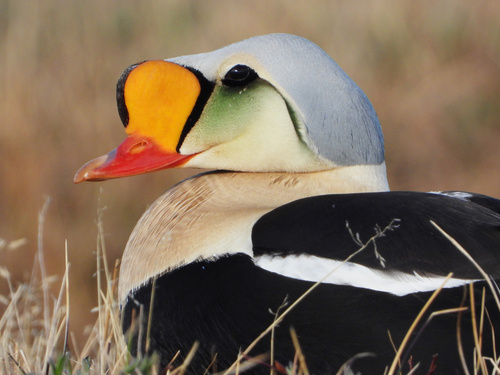
King Eider
The King Eider (*Somateria spectabilis*) is a large sea duck that breeds along Northern Hemisphere Arctic coasts of northeast Europe, North America and Asia. These strikingly beautiful birds spend most of the year in coastal marine ecosystems at high latitudes, migrating to the Arctic tundra to breed in June and July. They are known for their hardiness in extreme cold and their elaborate courtship displays. King Eiders play an important role in their ecosystems as both predators and prey, and have cultural significance for some indigenous Arctic peoples.
47-64 cm
Length
86-102 cm
Wingspan
Least Concern
Conservation Status
Distribution
Circumpolar distribution, breeding on Arctic coasts of Alaska, Canada, Greenland, Norway, and Russia. Winters along coastlines in eastern Canada and the US, western Greenland, Iceland, northern Norway, and the Bering Sea.
Lifespan
Up to 20 years in the wild, though average lifespan is shorter.
King Eider's Habitat
Habitat Types
Coastal marine waters, Arctic tundra (during breeding season), Bays, Estuaries
Climate Zones
Arctic, Subarctic
Adaptations
Dense down feathers for insulation in cold water; salt glands to excrete excess salt.
Variations
No recognized subspecies, but slight variations in size and plumage have been noted between Pacific and Atlantic populations.
Appearance
Breeding Plumage
Males have striking breeding plumage with a black body, white breast, and a multi-colored head with a large, orange knob above the bill. Females are brown overall. In non-breeding (eclipse) plumage, males are darker and less colorful.
Seasonal Feather Changes
Males molt into eclipse plumage after breeding, becoming darker. They regain breeding plumage in late winter.
Sex Based Plumage Differences
Highly pronounced. Males have bright, complex patterns; females are mottled brown for camouflage.
Notable Features
Large, sloping forehead and bill, Orange knob on male's bill during breeding season, Black 'V' marking on the chin of the males
Diet and Feeding
Primary Foods
Mollusks, Crustaceans, Echinoderms, Aquatic insects, Some plant material (during breeding season)
Foraging Behavior
Dives underwater to forage on the seabed, using its strong bill to pry prey from rocks. Often feeds in flocks.
Specializations
Serrated bill edges for gripping slippery prey.
Seasonal Diet Variations
Diet shifts slightly towards more plant matter and insects on freshwater breeding grounds.
Behavior
Social Structure
Forms large flocks during migration and winter. Pairs form during breeding season, but males do not maintain territories.
Communication
Cooing calls by males during courtship, Soft quacks by females, Visual displays
Migration
Migrates long distances between breeding and wintering grounds, often flying over land and sea. Timing and routes vary by population.
Territorial or Group Behaviors
Not territorial during breeding season, but may defend a small area around the nest. Forms large communal roosts in winter.
Conservation
Threats
Habitat degradation (oil spills, pollution), Climate change (affecting sea ice and prey availability), Hunting (subsistence hunting in some regions), Predation (by gulls, foxes, and other predators on eggs and chicks)
Protection Programs
Migratory Bird Treaty Act (in North America), Various regional and international conservation agreements
Local National Laws
Protected under various national laws in Arctic countries.
Population Trend
Stable
Population Estimates
Global population estimated at 800,000 - 900,000 individuals.
Interesting Facts
They can dive to depths of over 50 meters
This allows them to access food sources unavailable to many other duck species.
The male's colorful head pattern is unique to each individual
Similar to a human fingerprint, this may play a role in individual recognition.
King Eider down is highly prized for its insulation properties
Although not commercially harvested on a large scale, it is sometimes collected from nests after the birds have left.
Faqs about King Eider
Where can I see King Eiders?
Your best chance is during winter along the coasts of Alaska, eastern Canada, or northern Europe. They are rare visitors further south.
What is the purpose of the knob on the male's bill?
It is thought to be a visual signal used in courtship displays to attract females. It shrinks after the breeding season.
Are King Eiders related to Common Eiders?
Yes, they are in the same genus (Somateria), but the King Eider is generally found further north.
Copyright @ Nature Style Limited. All Rights Reserved.
 English
English